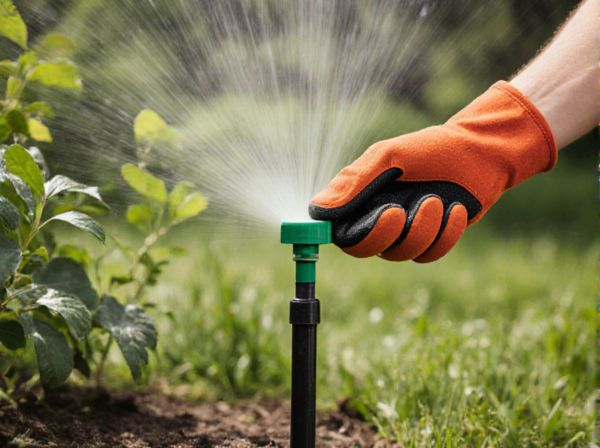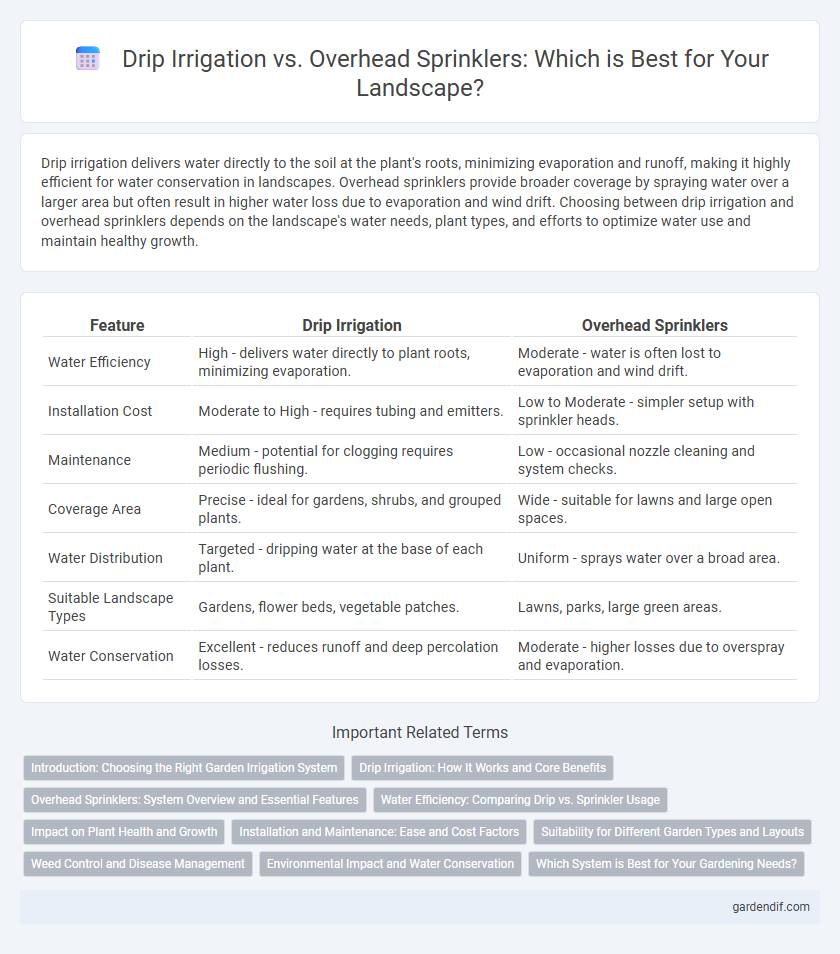
Drip Irrigation vs Overhead Sprinklers Illustration
Drip irrigation delivers water directly to the soil at the plant's roots, minimizing evaporation and runoff, making it highly efficient for water conservation in landscapes. Overhead sprinklers provide broader coverage by spraying water over a larger area but often result in higher water loss due to evaporation and wind drift. Choosing between drip irrigation and overhead sprinklers depends on the landscape's water needs, plant types, and efforts to optimize water use and maintain healthy growth.
Table of Comparison
| Feature | Drip Irrigation | Overhead Sprinklers |
|---|---|---|
| Water Efficiency | High - delivers water directly to plant roots, minimizing evaporation. | Moderate - water is often lost to evaporation and wind drift. |
| Installation Cost | Moderate to High - requires tubing and emitters. | Low to Moderate - simpler setup with sprinkler heads. |
| Maintenance | Medium - potential for clogging requires periodic flushing. | Low - occasional nozzle cleaning and system checks. |
| Coverage Area | Precise - ideal for gardens, shrubs, and grouped plants. | Wide - suitable for lawns and large open spaces. |
| Water Distribution | Targeted - dripping water at the base of each plant. | Uniform - sprays water over a broad area. |
| Suitable Landscape Types | Gardens, flower beds, vegetable patches. | Lawns, parks, large green areas. |
| Water Conservation | Excellent - reduces runoff and deep percolation losses. | Moderate - higher losses due to overspray and evaporation. |
Introduction: Choosing the Right Garden Irrigation System
Drip irrigation delivers water directly to plant roots, minimizing evaporation and promoting efficient water use in gardens. Overhead sprinklers distribute water broadly, suitable for lawns but often leading to higher water loss due to wind and evaporation. Selecting the optimal irrigation system depends on garden size, plant type, and water conservation goals.
Drip Irrigation: How It Works and Core Benefits
Drip irrigation delivers water directly to plant roots through a network of tubing, emitters, and valves, minimizing evaporation and runoff. This method enhances water efficiency by providing precise moisture levels tailored to specific plants, reducing overall water consumption by up to 50% compared to overhead sprinklers. Core benefits include improved plant health, weed reduction, and decreased nutrient leaching, making drip irrigation ideal for sustainable landscape management.
Overhead Sprinklers: System Overview and Essential Features
Overhead sprinklers distribute water through elevated spray heads, covering large landscape areas efficiently with adjustable spray patterns and radii. Key features include timed irrigation controls, pressure regulation, and customizable nozzle options to ensure uniform water application and reduce runoff. These systems are ideal for lawns and large gardens requiring consistent moisture over expansive zones.
Water Efficiency: Comparing Drip vs. Sprinkler Usage
Drip irrigation delivers water directly to plant roots, reducing evaporation and runoff, resulting in up to 50% greater water efficiency compared to overhead sprinklers. Overhead sprinklers distribute water over a wide area, leading to higher evaporation rates and potential water wastage, especially in windy or hot conditions. Effective water management using drip systems conserves water resources and supports sustainable landscaping practices.
Impact on Plant Health and Growth
Drip irrigation delivers water directly to the root zone, minimizing evaporation and reducing the risk of fungal diseases, thereby promoting healthier plant growth and higher yields. Overhead sprinklers increase leaf wetness, which can lead to fungal infections and uneven water distribution, potentially stressing plants and hindering development. Efficient water use in drip systems also prevents soil erosion and nutrient runoff, supporting long-term soil fertility and robust plant health.
Installation and Maintenance: Ease and Cost Factors
Drip irrigation systems require precise installation with emitters placed near plant roots, often involving higher initial setup costs but leading to water savings and reduced evaporation. Overhead sprinklers offer easier and quicker installation with lower upfront expenses, yet they demand regular maintenance to prevent clogged nozzles and uneven water distribution. Maintenance for drip systems centers around flushing lines and checking emitters, while sprinkler systems need seasonal adjustments and inspections to maintain efficiency.
Suitability for Different Garden Types and Layouts
Drip irrigation excels in gardens with diverse plant spacing, container arrangements, and irregular layouts by delivering water directly to root zones, minimizing runoff and evaporation. Overhead sprinklers suit large, uniform lawns or flower beds that benefit from broad coverage, but may cause water wastage in uneven or densely planted areas. Selecting the irrigation method depends on garden size, plant type, and layout complexity to maximize water efficiency and promote healthy growth.
Weed Control and Disease Management
Drip irrigation delivers water directly to the plant root zone, minimizing surface moisture and significantly reducing weed growth compared to overhead sprinklers, which wet the entire soil surface and encourage weed seed germination. By limiting leaf wetness, drip systems lower the risk of foliar diseases such as powdery mildew and fungal infections that thrive in damp conditions created by overhead sprinklers. Efficient water delivery through drip irrigation enhances disease management while providing targeted moisture, making it a superior choice for sustainable landscape maintenance.
Environmental Impact and Water Conservation
Drip irrigation minimizes water waste by delivering moisture directly to the root zone, reducing evaporation and runoff, which significantly conserves water compared to overhead sprinklers. Overhead sprinklers often cause water loss due to evaporation, wind drift, and overspray, leading to inefficient water use and higher energy consumption. Selecting drip irrigation supports sustainable landscaping by lowering water usage and minimizing environmental impact through targeted, efficient watering practices.
Which System is Best for Your Gardening Needs?
Drip irrigation delivers water directly to plant roots, enhancing water efficiency and reducing evaporation by up to 70%, making it ideal for gardens with water-sensitive plants or drought-prone areas. Overhead sprinklers cover larger areas quickly and maintain uniform moisture for lawns and established flower beds but can lead to water waste through evaporation and runoff. Choosing the best system depends on garden size, plant types, and water conservation goals, with drip irrigation favored for precision watering and overhead sprinklers suited for broad coverage.
Drip Irrigation vs Overhead Sprinklers Infographic

 gardendif.com
gardendif.com